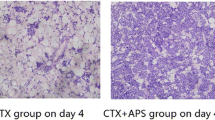Abstract
This study has shown that cyclosporine A (CyA), under certain conditions, is a powerful inhibitor of intravascular and extravascular monocyte/macrophage accumulation. Experiments were carried out in Lewis rats in which intravenous injection of particulate glucan calls forth a striking granulomatous response in lung, liver, and spleen and produces a marked stimulation of splenic erythro- and myelopoiesis. In agreement with the results of others, there was also a considerable elevation in monocyte/macrophage chemoattractant levels in the bronchoalveolar lavage fluid, which is held to be a key reaction in the pathogenesis of the histologic lesions. Treatment of the animals with subcutaneous injections of CyA prevented the rise in the chemoattractant activity and suppressed the granulomatous organ infiltration as well as the splenic hemopoiesis. The findings supply new insights into the activities of CyA and would support its clinical use in macrophage-dominated diseases.
Similar content being viewed by others
References
Yokum, D. E., J. B. Allen, S. M. Wahl, G. B. Calandra, andR. L. Wilder. 1986. Inhibition by cyclosporin A of streptococcal cell wall-induced arthritis and hepatic granulomas in rats.Arthritis Rheum. 29:262–273.
Geratz, J. D., K. B. Pryzwansky, J. H. Schwab, S. K. Anderle, andR. R. Tidwell. 1993. Suppression of local and systemic responses in streptococcal cell wall-induced acute inflammation of the air pouch by cyclosporine A. Comparison with the effects of two antiinflammatory bis-benzimidazoles.Am. J. Pathol. 142:1227–1237.
Di Lucio, N. R. 1976. Pharmacology of the reticuloendothelial system—accent on glucan.Adv. Exp. Med. Biol. 73A:412–421.
Deimann, W., andH. D. Fahimi. 1980. Hepatic granulomas induced by glucan. An ultrastructural and peroxidase-cytochemical study.Lab. Invest. 43:172–181.
Johnson, K. J., M. Glovsky, andD. Schrier. 1984. Pulmonary granulomatous vasculitis induced in rats by treatment with glucan.Am. J. Pathol. 114:515–516.
Bowers, G. J., M. L. Patchen, T. J. MacVittie, E. F. Hirsch, andM. P. Fink. 1986. A comparative evaluation of particulate and soluble glucan in an endotoxin model.Int. J. Immunopharmacol. 8:313–321.
Jones, M. L., andJ. S. Warren. 1989. Monocyte chemoattractant protein 1 in a rat model of pulmonary granulomatosis.Lab. Invest. 66:498–503.
Falk, W., R. H. Goodwin, Jr., andE. J. Leonard. 1980. A 48-well micro chemotaxis assembly for rapid and accurate measurement of leukocyte migration.J. Immunol. Methods 33:239–247.
Fawcett, D. W. 1955. An experimental study of mast cell degranulation and regeneration.Anat. Rec. 121:29–51.
Geratz, J. D., R. R. Tidwell, R. J. Lombardy, J. H. Schwab, S. K. Anderle, andK. B. Pryzwansky. 1991. Streptococcal cell wall-induced systemic disease. Beneficial effects oftrans-bis(5-amidino-2-benzimidazolyl)ethene, a novel, macrophage-directed antiinflammatory agent.Am. J. Pathol. 139:921–931.
Wahl, S. M., J. B. Allen, S. Dougherty, V. Evequoz, D. H. Pluznik, R. L. Wilder, A. R. Hand, andL. M. Wahl. 1986. T. lymphocyte-dependent evolution of bacterial cell wall-induced hepatic granulomas.J. Immunol. 137:2199–2209.
Geratz, J. D., R. R. Tidwell, J. H. Schwab, S. K. Anderle, andK. B. Pryzwansky. 1990. Sequential events in the pathogenesis of streptococcal cell wall-induced arthritis and their modulation by bis(5 amidino-2-benzimidazolyl)methane (BABIM).Am. J. Pathol. 136:909–921.
Niskanen, E. O., C. Burgaleta, M. J. Cline, andD. W. Golde. 1978. Effects of glucan, a macrophage activator, on murine hemopoietic cell proliferation in diffusion chambers in mice.Cancer Res. 38:1406–1409.
Rasmussen, L. T., P. E. Lipsky, andR. Seljelid. 1987. Production of prostaglandin E2 and interleukin 1 by mouse peritoneal macrophages stimulated withβ-1,3-d-glucan derivatized plastic beads.Scand. J. Immunol. 26:731–736.
Hoffmann, O. A., E. J. Olson, andA. H. Limper. 1993. Fungalβ-glucans modulate macrophage release of tumor necrosis factor-α in response to bacterial lipopolysaccharide.Immunol. Lett. 37:19–25.
Bevilacqua, M. P., J. S. Pober, M. E. Wheeler, R. S. Cotran, andM. A. Gimbrone, Jr. 1985. Interleukin-1 acts on cultured human vascular endothelium to increase adhesion of polymorphonuclear leukocytes, monocytes, and related leukocyte cell lines.J. Clin. Invest. 76:2003–2011.
Barton, P. A., M. M. Imlay, C. M. Flory, andJ. S. Warren. 1994. Role of intercellular adhesion molecule-1 (ICAM-1) in glucan-induced pulmonary granulomatosis in the rat.FASEB J. 8:A236.
Imlay, M. M., J. Shen, M. Alrawi, C. M. Flory, andJ. S. Warren. 1994. Locally produced monocyte chemoattractant protein-1 (MCP-1) mediates monocyte-endothelial adhesive and killing interactions.FASEB J. 8:A326.
Yoshimura, T., N. Yuhki, S. K. Moore, E. Apella, M. I. Lerman, andE. J. Leonard. 1989. Human monocyte chemoattractant protein-1 (MCP-1). Full-length cDNA cloning, expression in mitogen-stimulated blood mononuclear leukocytes, and sequence similarity to mouse competence gene JE.FEBS Lett. 244:487–493.
Rollins, B. J., T. Yoshimura, E. J. Leonard, andJ. S. Pober. 1990. Cytokine-activated human endothelial cells synthesize and secrete a monocyte chemoattractant, MCP-1/JE.Am. J. Pathol. 136:1229–1233.
Li, Y.-S., Y.-J. Shyy, J. G. Wright, A. J. Valente, J. F. Cornhill, andP. E. Kolattukudy. 1993. The expression of monocyte chemotactic protein (MCP-1) in human vascular endothelium in vitro and in vivo.Mol. Cell. Biol. 126:61–68.
Villiger, P. M., R. Terkeltaub, andM. Lotz. 1992. Monocyte chemoattractant protein-1 (MCP-1) expression in human articular cartilage.J. Clin. Invest. 90:488–496.
Introna, M., R. C. Bast, Jr., C. S. Tannenbaum, T. A. Hamilton, andD. O. Adams. 1987. The effect of LPS on expression of the early “competence” genes JE and KC in murine peritoneal macrophages.J. Immunol. 138:3891–3896.
Denholm, E. M., F. M. Wolber, andS. H. Phan. 1989. Secretion of monocyte chemotactic activity by alveolar macrophages.Am. J. Pathol. 135:571–580.
Szturm, K., J. R. Jeffery, D. N. Rush, andR. M. McKenna. 1989. Cyclosporin A and G inhibition of cytokine production.Transplant. Proc. 21:857.
Moutabarrik, A., S. Takahara, M. Namiki, Y. Kokado, T. Seguchi, K. Yokokawa, Y. Takano, D. Zaid, M. Ishibashi, andA. Okuyama. 1993. Effect of FK 506 and cyclosporine on the expression of IL-6 and its receptor on stimulated monocytes.Transplant. Proc. 25:2320–2321.
Author information
Authors and Affiliations
Rights and permissions
About this article
Cite this article
Geratz, J.D., Pryzwansky, K.B., Anderle, S.K. et al. Control of glucan-induced systemic granulomatosis by cyclosporine A. Inflammation 19, 221–231 (1995). https://doi.org/10.1007/BF01534463
Issue Date:
DOI: https://doi.org/10.1007/BF01534463




